
Douglas Between the Piers [Victoria Pier in background, Battery Pier in foreground]
[From The Tourist Vol 1 - 1897]
Part of a series of articles - this part 4 pp103/5]

Douglas Between the Piers [Victoria Pier in background, Battery Pier in foreground]
I have reason to believe that, in spite of so much having been both said and written about the Empress Queen the touring world-who, after all, are those most practically interested in her-look to our pages to give them the more faithful and abiding picture of the new vessel. I endeavour, therefore, not to disappoint them; but it would, however, ill become me to proceed in the manner ordinarily employed by those who tell us the saloon is so long, the ship so long, and the engines of so much power. The use of this curiously tabulated system is of value only in the way of bewildering one, except perhaps in the case of an explorative gentleman who is said to have betaken his steps to a field of commanding acreage and there to have significantly pegged out those dimensions of a ship he was otherwise wearily unable to comprehend
As many tourists reading these lines may not have fields at hand suitable for recreation of the laborious character mentioned, I have come to the old conclusion that a few pictures, carefully compiled (from convenient points of view), will present the matter in a much clearer light than mere words, the precise meaning of which is liable to differ according to the expansion or contraction of the reader's mind.
I now give the views of three interiors which speak for themselves in a language I am entirely unable to improve upon, and which show to what a plane of perfection the art of shipbuilding has now reached. It is easy, indeed, to be a critic, and doubtless hard enough to be a ship-builder. There seems so much to be provided for and then your handiwork is turned to the public view for the light approval or condemnation of those who are not at all concerned in the matter ! It is odd how cheerfully we all debate such affairs ! and how well anybody can do these two things, viz. criticise a boat and edit a newspaper!
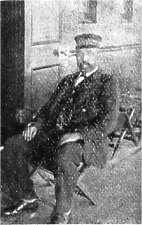
Mr Hudson, Chief Officer
So the Empress Queen has through this ordeal from the funny man on the pier head, who declared there was" a touch of the Ben about her," to the lady in the cabin who, unable to feel any vibration, somewhat angrily demanded that the ship, already a mile on her way should start !
If my readers will turn to the Tourist Club there they will see a brief reason given for the exceptional steadiness of the ship, which is due to her having three cylinders, so well and truly arranged as to turn the shaft with a singular absence of jar or vibration-call it what you will. so far all her passages have been three and a half hours for the seventy odd nautical miles and therefore she must be running on the latter day system of fixing an absolute time of arrival as of departure, just the same as a railway train. This is far better than running top speed. It is also fast enough for anything.
The views I give show the high art of her interiors, and in this no coaster can compare with her, as both cabin and steerage are fitted up in a way which astonishes one as a mere reflection on the lavish outlay.
 Main Saloon, looking admidships |
 Empress Queen: Ladies' Saloon |
 Empress Queen: Dining Saloon |
A few years ago channel boats regarded a smoking room as quite a superfluity, but now the Empress Queen has one on the upper deck, as well as provision for the function of afternoon tea, in fact, all the elements of the loungers cafe! !
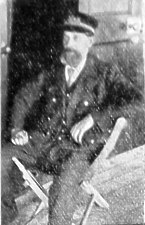 Mr Robinson, Second Officer |
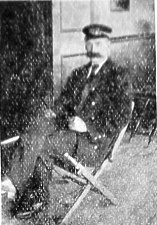 Mr Comish, Third Officer |
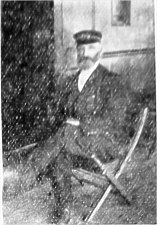 Mr T Kelly, Carpenter |
Britishers are said to be notoriously anxious for their interiors, and with this in mind, I made some enquiries on the subject. The gentleman able to make or mar our happiness on the steamers in this direction is Mr Ritchie, a citizen of endless activity, who, I must say, was as nearly successful as any one could be in eluding a Tourist photographer. But of course I got him, and it appears there are fifty stewards on the ship, a circumstance liable to stagger us with astonishment ! Fifty stewards ! and indeed the whole crew numbers some 110 persons, another fact hard for the ordinary traveller to believe. I might be speaking of an Atlantic Liner! It turns out that these fifty stewards execute orders of the most varied character, almost everything; being called for on the journey, indeed, I believe that nearly a thousand cups of tea have been served, showing an increasing love for the cup which cheers us without inebriating. At all events tourists are well catered for, and I have taken the liberty of stealing a menu card, showing what Mr. Ritchie complacently dismisses as a mere luncheon.
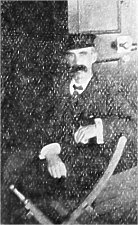
Mr Ritchie, Co's Caterer
But the feature of the steamer is undeniably the promenade deck over the upper one, and nothing can surpass the felicity of the marine walk, for, even if the weather be wet, the roof of the deck in question gives a shelter below which still enables the traveller to remain in the open-air-a feature of wide attractiveness.
Thus, whether one is a cabin or a steerage passenger by this remarkable boat, the arrangements designed on every hand for ensuring comfort are as little short of perfection as Glasgow-the home of ship-building-could make them. As a traveller in many waters, it gives me pleasure to put in a word for even so august a body as the Fairfield Company.
I often notice the sea tourist, whetherbe he on his way to the Island, to the Clyde, to Dublin, or in the English Channel, stare enquiringly at the Captain and officers. He wants to know something about these wonderful men who have reached such high positions. Liners have things written about their crews, and I make the departure of doing the like for the coaster
.
Perhaps it will here be convenient for me to remark that, in all the world, Manx men rank first as sailors, a fact not in the least surprising when the nearness of the sea, to the place of their birth be, thought about. The fact is they are sailors from the time they walk, and the Packet Company has the pick of them ! Since my opening remarks in May last Capt McQueen has resigned the command he has held for so many years, much to everyone's regret. I gave the worthy captain's photo. in May, and I hope again to refer to his many achievements, for I believe he is the holder of a master's ticket for a. longer period than anyone in the world. I have an excellent negative of Captain Keig, his. successor, which I am compelled to hold over till next month, as well as a full side view of the ship.
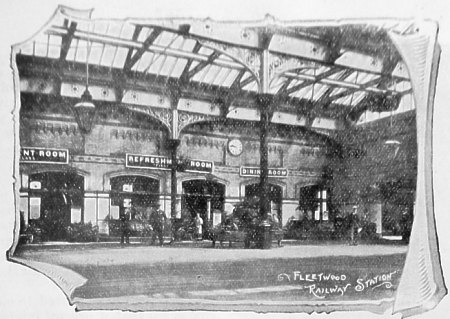
Fleetwood Railway Station
I AM beginning quite to feel the everyday effect of our England being mistress of the seas! In what way? Well, in the spontaneous and hearty manner, for one thing, in which my notes on the famous men and old steam packet boats have been received. I am convinced of our seafaring instincts at heart, and I am now alluding, it must be remembered, to dwellers in the inland towns almost as much as to those on the coast, and in sight of boats-be they canoe or lugger, smack or barque, or Atlantic liner.
I should like to assure my readers that other well-known steamship lines will follow. There are many of them, although they may not, perhaps, offer so sentimental and engaging a point of view as the Manx vessels, trading as they do to the little insular kingdom in the Irish Sea, or whatever you like best to call it. Yes, I hope to have many other treats in store.
I have already stated that this remarkable Company, in the sixty-seven years of its existence, have had but but four commodores. This was in May last. They have now reached a fifth. The first and the second have been duly pictured, and Mr. Brown has told us something of their leading characteristics. In this issue he gives us an idea of the third, the brave old Captain Kermode. The fourth, Captain McQueen, has already been pictured by me. It is he who, since our last issue, has retired, after having served as master of a ship for fifty years, save but one short month. I believe no other commander has such a record.

Captain Hill,
of the "Mona's Queen", the new Commodore
But years go on, and men with them, and now I have to welcome and to picture Captain Hill, the present senior captain, and the proud flyer of the much-prized commodore's pennant. Captain Hill has been in the boats for, I think, thirty-two years, and is, of course, every inch a sailor, a fact which naturally goes without the saying. His ship is the Mona's Queen, and is on the. Fleetwood station. I have, much gratification in adding him to my gallery of maritime celebrities, and may he long enjoy the high position which he has reached.
.
Captain Keig of the Empress Queen
I want now to interpose a word about the old Snaefell, pictured in Mr. Brown's, present article on the Old Captains. We have seen the first steamer, the tiny Mona's Isle, and the third, the scarcely bigger Queen of the Isle, but the Snaefell brings us in sight of more modern developments. For practical purposes we may date her as representing the most splendid coaster of about the year 1860. My picture is as she was originally, but, I may remark, that the present type of captain's bridge, that is, from paddle-box to paddle-box, was subsequently added to her. In other ways she was practically unchanged In her day she was, of course, highly renowned for both speed and comfort ; nevertheless she had to bow to the march of progress and enterprise, and be sold to make room for still bigger and faster boats. It is odd, however, that she continued her career on the east coast as a noted ship for years after the seafaring Manxlanders had done with her.
Now, a comparison of the three: boats I have named serves as a lesson to us all in the way of quickly understanding what the tourist is treated to, in this year of grace and jubilee, in the noble Empress Queen, whose portrait--I am speaking of her. as if she was a being alive ! I also present, and on a more elaborate scale than usual.
I give a full view of the ship as she, appears under steam, and, by doing; so I necessarily cancel the photo which appeared in May last, on page 15. It is here convenient to explain that, at the period in question, the Empress Queen was not fully rigged and that our drawing was partly from the model of what she was intended to be and given as the evidence of literary enterprise, and also bein the first ship ever issued to the world. But today I supplement it by a new one, absolutely correct.
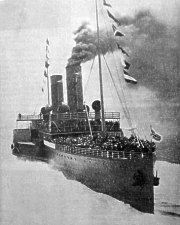
Empress Queen
The photograph shows the new ship steaming astern, the water being thrown up forward of her and not in the wake as when
she goes ahead.
The Empress Queen has already broken the record between Liverpool and Douglas and will make the passage quicker still, by-and -bye.
The ship is taken as she, is steaming astern (aided by her powerful bow rudder) and I think her going backwards makes a even a more artistic picture, than her going ahead-anyway, it is more novel, and surely to be novel and original, is the of latter-date journalism.
My readers have proved to me over and over again that a general interest is taken in ships, and that the kind of interest I mean differs in the most complete manner from that taken in railways trains, locos., or what you will. Who cares where the engine was built which drags the tourist ill the fastest express? as like as not it may be twenty years old or more, re-boilered and re-painted, and what not! But a noble ship! Why the smallest traveller keeps a note of when she was launched, and what she has done, and all about her. He begins to regard her reputation as almost a personal possession of his own.
I thus present the great Empress Queen to my readers. More than this I am able now to certify-I use the word in its strongest sense-that she has proved a good sea boat in all weathers. I know everyone expected she would, and she has done it.
Since Captain M'Queen retired I am called upon to chronicle the face and figure of his successor, Captain Thomas Keig. I imagine I have but little to say about him, save that he is one of the real Manx, a " sailor man " (I believe this is what they like to be called) from a boy, and that he has commanded all sorts of ships, schooners, square rigs and steamers, little and big, in his time. Much to his credit he shines also in various other ways.

A snap on the Mona's Isle
Preparing to disembark
But a steamer is not of much account without her engines, and the 10,000 h.p. engines of the Empress Queen are so enormous that the control of them is in itself a matter of no little responsibility ; and here again I am faced with another worthy Manxrnan, who, in his way, is perhaps equally noted. I therefore add the portrait of Mr. John Robert Kelly, the chief engineer, and till recently of the then biggest ship in the company, the present Mona's Isle. I sometimes envy then engineers their knowledge of complex machinery. I believe a real cricketer can detect a good pitch with his eyes shut, from the feel of the turf; in like Irla,nnera good engineer can tell the state of his engines from the hum and the music of their revolutions. No sweeter Music is there to him than the even song they sing. My ambition has been to present to my readers typical officers in the employ I must give old Mr. Moore, the very highly respected engineer of the Snaefell, which would never, for a moment, be complete without him.
 Mr John Robert Kelly Chief Engineer of the Empress Queen |
 Mr John Moore Chief Engineer of the Snaefell and second oldest engineer in the service |
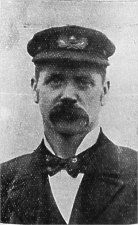 Mr J McLaughlan Chief Steward of the King Orry |
Then among many excellent chief stewards is Mr. McLaughlan, of the King Orry, and I hope soon to give other of his co-workers.
|
|
||
| Part 3 | ||
|
|
||
|
Any comments, errors or omissions gratefully received The
Editor |
||